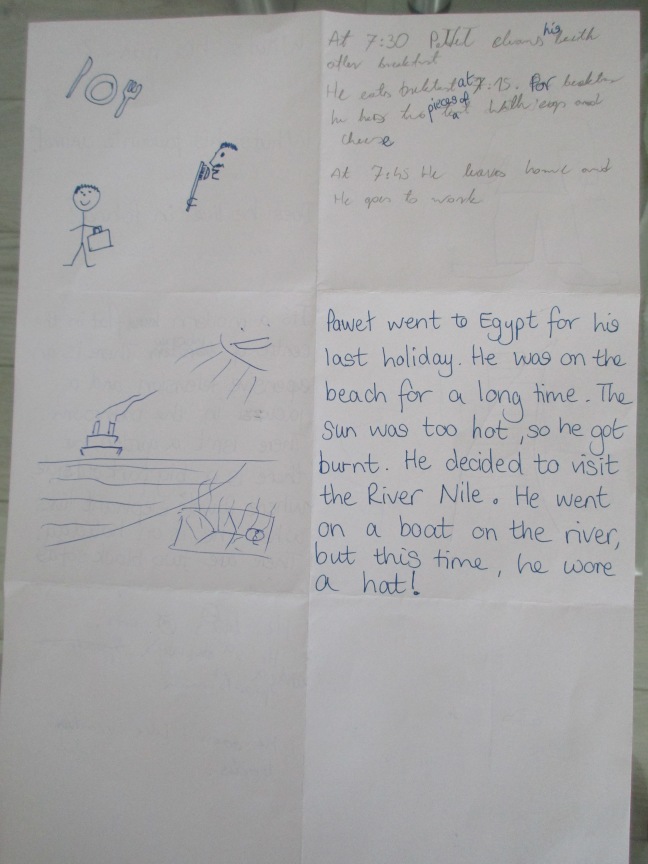Tuesday evening. 7:15pm. I walk out of the cover lesson I’ve just completed, working with a lovely group of pre-intermediate teens. Running through my head: right, I need to take the key downstairs, pick up my stuff, and pop into the supermarket on the way home. Followed almost immediately by: [Four-letter word], I forgot to find cover for the last lesson! That’s my evening out the window! Cue 10 minutes of running around trying to work out where to get some food from to get me through the rest of the evening (thanks Shannon and Emma!), telling people how stupid I am, and canvassing for ideas for an unplanned cover lesson with low elementary adults I haven’t met before.
As (nearly) always with these things, the lesson itself was absolutely fine. Two students came, one of whom had forgotten to do his homework. The first 45 minutes were spent working on pronunciation of comparatives from the homework, and with them testing each other, plus practice of very large numbers. For the other half of the lesson, I gave them the choice of unplanned functional language (the next spread in the book), unplanned superlatives (the spread after), or revision (which they’d also had, along with a test, in the previous lesson). They went for revision, and this is the activity which I came up with, based loosely on collaborative profiles, an idea suggested by my colleague Sam just before the lesson (thanks!) I joined in to, so see if you can work out which drawings were mine!
Revision squares
- Fold A4 paper into 6 squares (or 8 if you have more language points).
- In the first box, each person draws a person.
- (Optional) In the second box, the next person asks three questions about the person. (This didn’t work very well, as I hadn’t thought it through, and I decided I wanted different people’s drawings on each paper, not the same person every time in our group of three.)
- In the second box, the next person answers the questions about the person/writes a basic profile describing them.
- Pass the paper on (do this after each stage to get a truly collaborative piece of work). Under the person, draw where they live.
- Write about where they live.
- Draw two or three hobbies, plus one thing they can’t do.
- Write about them.
- Draw three things they do every morning.
- Guess what…write about them!
- Draw their last holiday.
- Write about it.
As the paper was passed on, I encouraged the students to read what others had written and link their texts if they wanted to. I also corrected texts as part of my turn, because it was obviously a bit easier for me to write! The students asked me questions about what they were writing, and about my corrections. There was also negotiation in English as we tried to work out what other people had drawn. Obviously with only two students, it wasn’t that hard, so you might have to think about how/if you want to correct/join in if you’re using the activity with a bigger group. To round it off, we all read all three stories quickly and decided which person we would like to be friends with and why.
In about 30 minutes, these elementary students produced about 100 words of English, and practised:
- question forms
- interpreting and replying to basic questions
- There is/are
- rooms and furniture
- like + -ing
- can/can’t
- hobbies
- daily routine
- past simple
- holiday vocabulary
- prepositional phrases of various kinds (time, place, manner)
- vocabulary they wanted to use, based on their drawings
We had an empty box as we ran out of time, but I think I probably would have done something with future plans, like plans for the next weekend, though I don’t think they’d got to that in their book. Alternatively, drawing their family, their job, their favourite clothes…lots of options!
I’m pretty sure it could be adapted for a wide range of other language. I’d be interested to hear what you decide to do with it.








Love it! Thanks!!! Can’t wait to try it out with my students! 😁
LikeLiked by 1 person
so cool!! Great work I’ll use this for my classes and see what I get from them!! Thanks a ton!!
LikeLiked by 1 person
ps my classes are actual efl classes (English as a foreign language) therefore not cover/supply but I reckon this will work fine for them too!! Cheers:)
LikeLike
Let me know how it goes!
LikeLike
sure they’ll be glad to do anything other than what’s in their course book:)
LikeLike
I love it! Can’t wait to try it out! I love that they have to write about fictional people and not answer the same questions about themselves over and over. Question – did you check/correct the questions in the first square in any way or give feedback on any other parts? Or did you just want them producing language and working on their fluency?
LikeLike
Hi Yuliya,
Because there were only two students and I joined in with the activity, I could correct as I went along. Another option might be to add a self-correction stage at the end of the activity, where students have a chance to correct pieces in pairs before they’re shared with the whole group. In this case it was mostly to show these elementary students that they are able to communicate, and to revise various different structures they’ve been introduced to.
Looking forward to hearing how it goes with your groups.
Sandy
LikeLike